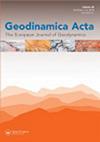土耳其中北部贝帕扎尔伊花岗质岩体锆石年龄:构造意义
IF 1.5
Q1 Earth and Planetary Sciences
引用次数: 13
摘要
贝帕扎尔伊花岗岩类位于土耳其中北部的晚白垩世火山弧中,为新特提斯洋闭合期间发生的过程提供了证据。其北部花岗闪长岩和石英二长岩的锆石在岩石薄片上测年,阴极发光(CL)显示出典型的火成岩分带特征。其最古老的晚白垩世年龄(95.4±4.2-91.3±6.5 Ma, 238U/206Pb,±1σ)是上升熔体的早期结晶,但复合cl -二次电子图像显示,最年轻的晶粒位于被蚀变织体包围的晶界上,可能受到流体驱动变质作用的影响。锆石中缘年龄(82.7±6.0 ~ 70.5±3.4 Ma)记录了岩体的连续结晶过程。在这里,我们模拟了晚白垩世beypazarir花岗岩类的发育,其中新特提斯大洋板块的俯冲、岩浆的多次注入和混合以及上升过程中的地壳贡献是岩体内地球化学非均质性的原因,并解释了锆石的长期结晶。该模型推测,该岩体位于一系列堆积的北倾俯冲带的上部构造板块中,这些俯冲带记录了土耳其地质组合期间新特提斯海洋盆地的关闭。本文章由计算机程序翻译,如有差异,请以英文原文为准。
Zircon ages from the Beypazarı granitoid pluton (north central Turkey): tectonic implications
The Beypazarı granitoid is emplaced in a Late Cretaceous volcanic arc in north central Turkey and provides evidence for processes that occurred during the closure of the Neo-Tethys Ocean. Zircons from its northern granodiorite and quartz monzonite exposure are dated in rock thin section and display characteristic igneous zoning in cathodoluminescence (CL). Its oldest Late Cretaceous ages (95.4 ± 4.2–91.3 ± 6.5 Ma, 238U/206Pb, ±1σ) time early crystallization from rising melts, but inspection of the youngest grains in composite CL–secondary electron images shows they are located along grain boundaries surrounded by alteration textures and were possibly affected by fluid-driven metamorphism. Ages obtained from zircon mid-rims (82.7 ± 6.0–70.5 ± 3.4 Ma) record continuous crystallization of the pluton. Here, we model the Late Cretaceous development of the Beypazarı granitoid wherein subduction of Neo-Tethys Oceanic plate, multiple injections and mixing of magma, and crustal contribution during ascent are the cause of geochemical heterogeneities within the pluton and account for protracted zircon crystallization. The model speculates that the pluton is in the overriding tectonic plate of a series of stacked, north-dipping subduction zones that record the closure of Neo-Tethys ocean basins during the geologic assembly of Turkey.
求助全文
通过发布文献求助,成功后即可免费获取论文全文。
去求助
来源期刊

Geodinamica Acta
地学-地球科学综合
CiteScore
4.50
自引率
0.00%
发文量
0
审稿时长
25 weeks
期刊介绍:
Geodinamica Acta provides an international and interdisciplinary forum for the publication of results of recent research dealing with both internal and external geodynamics. Its aims to promote discussion between the various disciplines that work on the dynamics of the lithosphere and hydrosphere. There are no constraints over themes, provided the main thrust of the paper relates to Earth''s internal and external geodynamics. The Journal encourages the submission of papers in all fields of earth sciences, such as biostratigraphy, geochemistry, geochronology and thermochronology, geohazards and their societal impacts, geomorphology, geophysics, glaciology, igneous and metamorphic petrology, magmatism, marine geology, metamorphism, mineral-deposits and energy resources, mineralogy, orogeny, palaeoclimatology, palaeoecology, paleoceanograpgy, palaeontology, petroleum geology, sedimentology, seismology and earthquakes, stratigraphy, structural geology, surface processes, tectonics (neoteoctonic, plate tectonics, seismo-tectonics, Active tectonics) and volcanism.
Geodinamica Acta publishes high quality, peer-reviewed original and timely scientific papers, comprehensive review articles on hot topics of current interest, rapid communications relating to a significant advance in the earth sciences with broad interest, and discussions of papers that have already appeared in recent issues of the journal. Book reviews are also included. Submitted papers must have international appeal and regional implications; they should present work that would be of interest to many different specialists. Geographic coverage is global and work on any part of the world is considered. The Journal also publishes thematic sets of papers on topical aspects of earth sciences or special issues of selected papers from conferences.
 求助内容:
求助内容: 应助结果提醒方式:
应助结果提醒方式:


